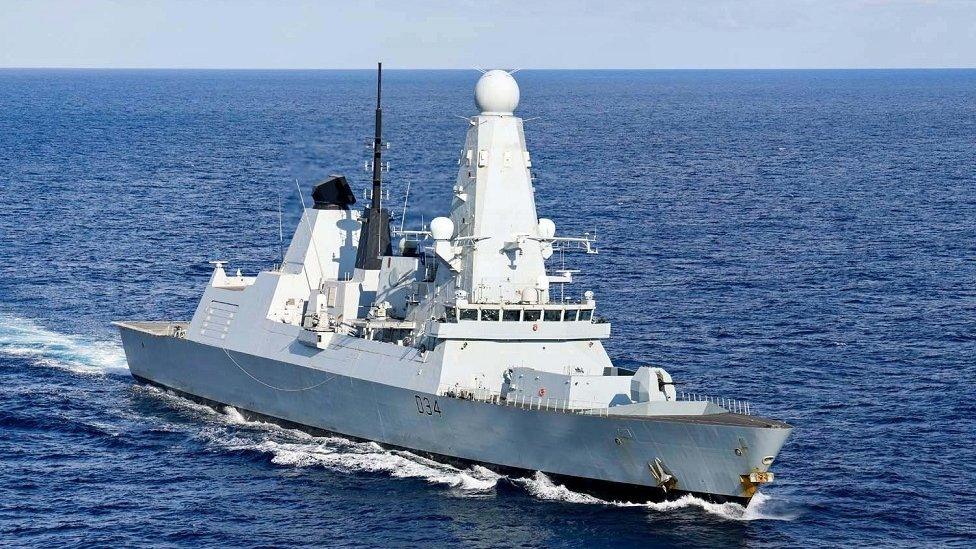Navy destroyer HMS Diamond returns from Red Sea

The destroyer has been deployed for 10 months
- Published
Royal Navy destroyer HMS Diamond has returned to the UK after six months in the Red Sea and Gulf of Aden helping to protect shipping from attacks by Yemen's Houthi rebels.
The warship shot down nine drones and a Houthi missile, sailing nearly 44,000 miles and spending 151 days at sea, the Ministry of Defence (MoD) said.
The Type 45 destroyer - which will be replaced in the region by HMS Duncan after it left the UK in May - was welcomed back to its home port of Portsmouth on Saturday.
Crew members told of their pride in the Middle East deployment as they were reunited with family members, some of whom sailed with the ship as it came into port.
"My wife, Emma, has been mum and dad for months. I'm looking forward to just being around her, and we are overdue a date night," Leading Writer Ben Maple said.
"To know we saved lives will stay with me forever. After only seeing my loving wife and three children for four weeks since September 2023, I am looking forward to seeing my children smile and to see how much they have grown."
HMS Diamond operated in the region in December and January when it came under fire from Iran-backed Houthi forces on three separate occasions.
It returned again in March, taking over protection duties from frigate HMS Richmond.
Nas Naseem, Able Rating (Above Water Tactical), said: "We made history working with coalition nations and Diamond's presence has definitely saved lives.
"It feels good to be returning home - I never thought I would say this but I'm excited to experience what I hope is a cold and rainy summer.
"What I'm looking forward to most is spending time with the family and watching the Euros."
On 9 January, the ship used its Sea Viper missiles to shoot down seven drones aimed at merchant vessels by the Houthis which, according to the MoD, is the most aerial threats neutralised by a Royal Navy warship in modern times in one day.
Recalling that night, Lieutenant Freddy Hamblin, Diamond's Officer of the Watch 4, said: "As they closed on us the apprehension and excitement built and it was great to see the crew's training kicking in.
"When US Navy units began engaging the sky lit up with orange sparks like fireworks. When you engage with Sea Viper, the whole bridge shakes and there's a bright flash and a loud whoosh, followed by silence and darkness."
In April, HMS Diamond shot down a missile launched by the Houthi group targeting a merchant vessel in the Gulf of Aden.
The MoD described the successful takedown as a "landmark moment", adding "never has a British ship, aircraft or otherwise engaged a target travelling so fast".
The Yemen-based Houthi group has targeted shipping in the Red Sea and Gulf of Aden, claiming its actions are in response to Israel's war on Hamas in Gaza - an assertion dismissed by the UK and allies.
In total, the destroyer has been deployed for 10 months and has been involved in other activities across that time, including seizing 2.4 tonnes of drugs in the Indian Ocean.
Commanding Officer Peter Evans called the sailors on board "fantastic" and said they had demonstrated "courage, professionalism and the very best of teamwork".
Defence Secretary John Healey thanked the crew for their "exceptional service" which he says helped to "ensure global trade continues to flow, protecting this country and our economy".
HMS Duncan is a like-for-like replacement for Diamond, and is armed with the same Sea Viper missile system and equipped with the same radar systems.
The MoD said in May that HMS Duncan spent five months leading NATO’s premier task group in the Mediterranean Sea last year, before handing over flagship duties to the Italian Navy in December.
Related topics
- Published25 April 2024

- Published14 June 2024
